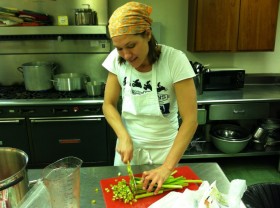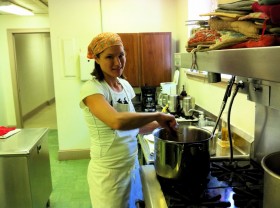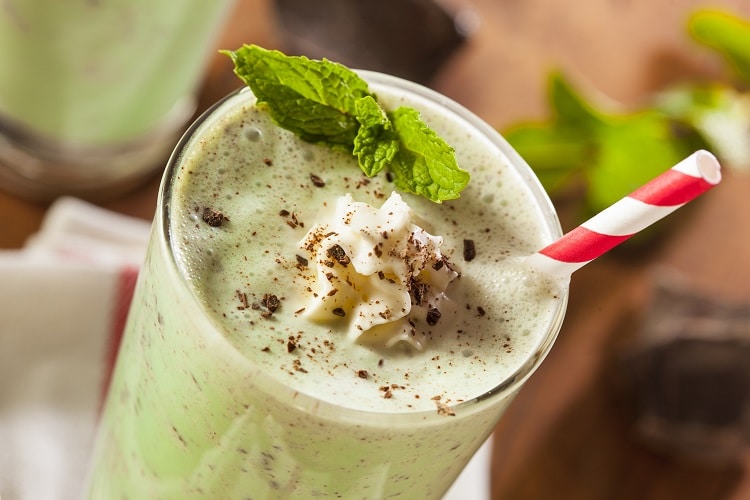Amanda Silver has a passion for jam. From the kitchen of her church basement on South Broad Street, she handcrafts exotic jams in small batches that are sold at a few select stores and the occasional growers market under the name “Amanda’s Hand-made Jams and Jellies.”
The individual jars carry names such as Decadence, Crown of Thorns, Vein of Gold and π. On the back label is an explanation – choose between wild blackberry, peach-rhubarb, pear, ginger pumpkin, or several others. She is always creating new variations.

When I stop in to watch her create two batches of her popular strawberry rhubarb jam, two giant pots boil away on the stove sanitizing the jars and lids. The stove top rattles and the exhaust fan hums in the background.
As Amanda dices up fresh rhubarb from her own garden, she tells me her origins. Although she has lived in Kennett Square for ten years, she grew up on a farm in Connecticut. “I watched my mom make jam all my life,” Amanda says, “though I didn’t pay much attention to it when I was younger.” It wasn’t until Amanda’s daughter Nina began asking questions about grandma’s jam that Amanda started making her own jam and began her journey. Now, she tries to schedule occasional mornings in the church kitchen, usually while her two kids are in school, to make fresh batches of whatever jams she has recently dreamed up.
As we chat, she stirs the strawberries and rhubarb with a bit of sugar, and is careful to bring it all to a slow boil. Amanda is very particular in her preparations for the jam. As she adds sugar slowly into the mix, I smell the fruit and the sugar wafting up from the pot.
 While slowly mixing the pot, Amanda explains Mandarin Marmalade is the most challenging to make. “The mandarin is a neat process–it takes a lot of soaking in the refrigerator. The reason you do that is to allow the cells in the skin to open up to receive the sugar because it’s not bitter after I make it. There’s a lot of quicker ways to make marmalade but it’s bitter because you didn’t take the time to soak everything. After you soak it for a day or two, and you cut them, cook them, and you let them cool down again and put them in the fridge again for a day or two – that’s always a really intense jarring experience.”
While slowly mixing the pot, Amanda explains Mandarin Marmalade is the most challenging to make. “The mandarin is a neat process–it takes a lot of soaking in the refrigerator. The reason you do that is to allow the cells in the skin to open up to receive the sugar because it’s not bitter after I make it. There’s a lot of quicker ways to make marmalade but it’s bitter because you didn’t take the time to soak everything. After you soak it for a day or two, and you cut them, cook them, and you let them cool down again and put them in the fridge again for a day or two – that’s always a really intense jarring experience.”
She continually stirs the strawberry rhubarb, frequently monitoring the consistency. After a few minutes, she holds up the spoon, “If you let it drip off the spoon, it’s sheeting. It’s falling in a sheet.” She quickly removes it from the heat. “Less cooking is better.” After it’s boiled, she carefully skims off the froth on top and then takes a metal funnel to pour the jam into the bitty jars. She moves about the kitchen, meticulous in her actions, graceful in her preparations. Using rubber oven mitts, she carefully holds out a jar and places a metal funnel on top. She ladles the strawberry rhubarb in, before carefully placing a lid on top and securing it. Occasionally, she catches a smudge on the rim of the bottle and wipes it clean.
Amanda tries to source all her fruit locally. She uses fruit from her property and from local farms. “I have an Amish connection,” she explains. “They get me big peaches, black raspberries.” Fall is her busiest time, but she gathers and freezes fruit throughout the summer until she can get into the kitchen.
Amanda’s Jams come in three sizes: 2 ounce, 4 ounce and 9 ounce jars. She also makes a few sugar-free jams. Some jams have seed but others are seed free. Amanda does not have a website but can be reached on email at [email protected]. You can pick up her jams at Mrs. Robinson’s Tea Shop.
View more scenes from the recent jam-making session, plus hear Amanda discuss the process further via the slideshow below.



